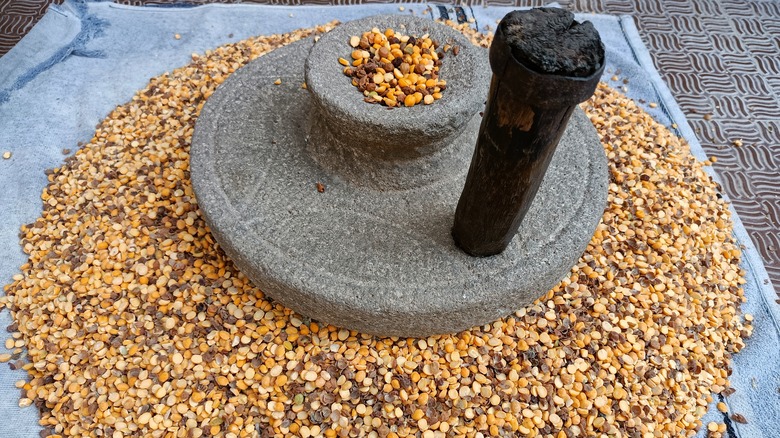What's The Difference Between Hominy Grits And Stone-Ground?
Like hush puppies, red-eye gravy, Brunswick stew, and fried green tomatoes, stone-ground and hominy grits are as Southern as food gets. But are they the same as some people assume? Stone-ground and hominy grits share many similarities, but preparation and processing also determine what makes them different.
Ground corn has provided sustenance for indigenous people and colonial settlers for centuries. According to NPR, evidence of the staple has been unearthed, indicating that this mainstay of Southern cooking dates back to 8700 B.C. in Central America. Per Real Simple, members of the Muskogee tribe in 16th-century Tennessee, Alabama, Georgia, and Florida offered dried ground corn to colonists. Sir Walter Raleigh's crew also wrote about the food, and Jamestown settlers were instructed on how to cook it. Culture Trip explains that the natives called it "rockahomine," a term the Europeans shortened to hominy. Colonists also referred to the victuals as "grist" before they became known as grits.
Enslaved people have a hand in the origin story of grits, as they were permitted to eat corn, and they bolstered it with surreptitiously caught shrimp — a forerunner of today's popular shrimp and grits. Grits and hominy have since become fixtures in home kitchens, and grits recipes are featured at the Waffle House and in elite restaurants. South Carolina even designated grits as the official state food, declaring, "A man full of grits is a man of peace."
Stone-ground grits vs. hominy
Stone-ground grits and hominy grits are derived from so-called dent corn, also known as field corn. It is a variety that is soft and starchy, low in sugar, and with indented kernels. Stone-ground grits are created by coarsely grinding dried, whole corn kernels in a mill or between stones, as has been done throughout history. Often, stone-ground grits are composed of white corn, but they can also be from yellow or blue.
Per Orlando Magazine, hominy differs from stone-ground grits in that it is treated in a process known as nixtamalization. The corn used for hominy is soaked in an alkali solution before grinding, using either culinary lime (not citrus lime) or diluted lye. Doing so softens the kernels' hard hull, known as the pericarp, and the Food Network asserts it makes grinding the corn and cooking the hominy easier. The end product is dried and ground up to make hominy grits or canned as a ready-to-eat product. Hominy can be derived from white or yellow corn; the more golden variety is the sweetest. It is available in fine, medium, or coarsely ground. Hominy is a central ingredient of the Mexican pork soup/stew pozole.
Differences in taste and nutrition
Stone-ground grits consist of the entire kernel, so they have a more pronounced texture than varieties such as hominy that lack the hull and germ. Nixtamalization removes the germ but also excises the extraneous part of the kernel with the least taste. The hominy is left with a more earthy, nutty, and sweeter flavor than stone-ground grits. Stone-ground grits may also have a flecked appearance compared to hominy and are creamier when cooked, and hominy has a more puffy texture. Grits tend to be relatively bland but absorb the taste of what they are cooked with, and stone-ground grits have a more corn-like flavor than the earthier hominy.
Stone-ground grits retain more fiber and nutrition than their more processed relatives, hominy or quick or instant grits. According to Food Struct, hominy has significantly less iron, fewer B vitamins, and lower amounts of minerals, including folate, calcium, magnesium, phosphorous, and potassium, than the stone-ground variety. However, it points out that hominy is lower than stone-ground grits in carbs, saturated fat, and calories and has a lower glycemic index. The nixtamalization process also breaks down the corn's cellulose, making it easier to digest than when corn is untreated. Healthline says that the processing that results in hominy also allows for better absorption of niacin and amino acids.
While grits and hominy are both central ingredients in some delicious dishes, they bring different things to the table regarding flavor and health benefits.


